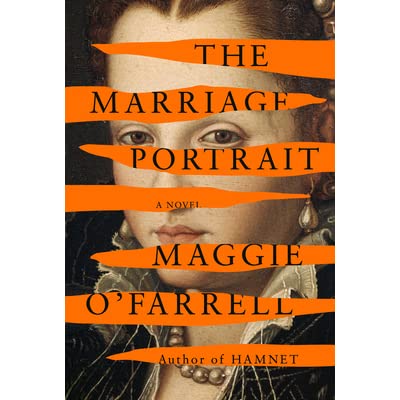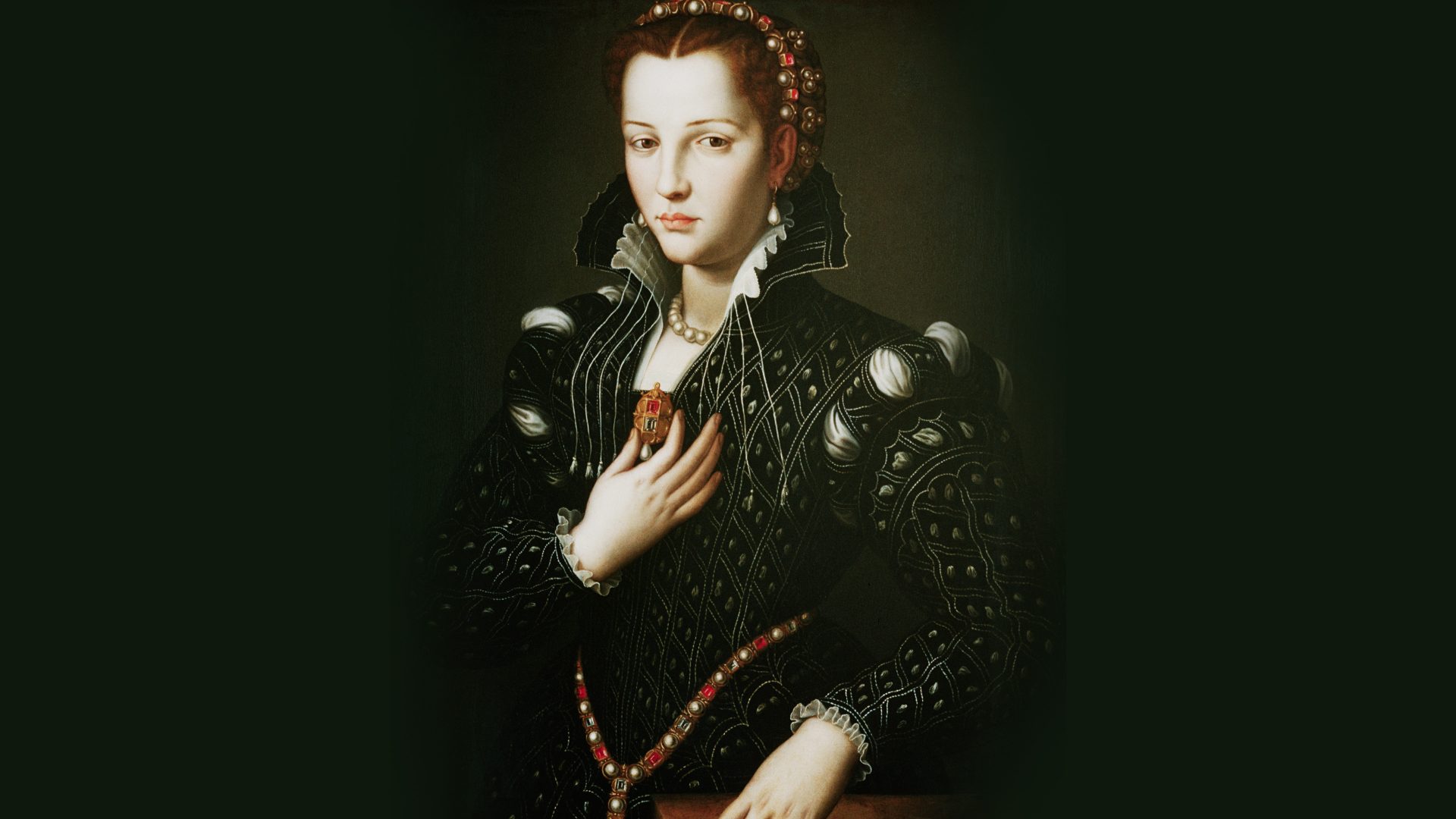Perhaps the most tantalising aspect of the historical record is what might lie in the spaces between the facts. We can know when someone was born, who they married and when, the children they had, when they died and where they’re buried. We might even be lucky enough to have a few letters or contemporary accounts. It’s all just raw data though, the barest of facts that can give only the most cursory glimpses of a life.
We know, for example, that Lucrezia de’ Medici was born in Florence on St Valentine’s Day 1545, the fifth child and third daughter of Cosimo I de’ Medici, the Grand Duke of Tuscany and his wife Eleanor of Toledo. We know that despite receiving a good education her destiny in life was, like most European women of noble birth, to become one half of a politically advantageous marriage and produce good, healthy male babies in order to continue the dynasty and consolidate power.
We know that Lucrezia was betrothed at the age of 13 to Alfonso d’Este, the Hereditary Duke of Ferrara, who would have married Lucrezia’s older sister Maria had she not fallen ill and died at the age of 17. We know that the couple married in Florence in the summer of 1558 and Lucrezia’s husband went off to fight in France, leaving her in Florence until his return.
We also know that Alfonso became Duke on the death of his father in 1559 and that he returned for his bride the following year and escorted her to Ferrara. Lucrezia, Duchess of Ferrara, died on April 15 1561 of “putrid fever” a few weeks after her 16th birthday. There were no children.
Among the frequently thrilling potboiling machinations of Renaissance Italy, Lucrezia’s story is barely a footnote. The same goes for the Dukes of Ferrara: Alfonso married twice more, yet still failed to produce an heir, meaning the end of the House of d’Este and the absorption of the Duchy of Ferrara into the Papal States a year after the Duke’s death.
The brief list of facts about Lucrezia’s short life make her easy to bypass, but even the most cursory reading between the lines reveals the tragedy of a young woman who was married off when still a girl, someone who barely had the chance to find out who she was or establish her place in the world before she was dead. Who was she? What made her laugh? What did she love to do? What, in short, was going on in Lucrezia’s life when history was busy looking at other things?
For once, we have possible answers to those questions. Despite being barely a backwater of the great flowing current of European history, Lucrezia’s life has proved inspiring in the halfmillennium since her death. Possibly prompted by rumours that the Duchess had been poisoned by the Duke for not bearing him a child, Robert Browning made Lucrezia the subject of his 1842 poem Ferrara. A dramatic monologue spoken from her husband’s point of view, the poem sees Alfonso giving the father of his soon-to-be-second wife, Barbara of Austria, a tour of his art collection, including a portrait of Lucrezia he’d commissioned that he keeps behind a curtain and allows only a select few to see.
“That’s my last Duchess painted on the wall, looking as if she were alive,” he begins, before describing the “depth and passion” of her “earnest glance” betraying “a heart – how shall I say? – too soon made glad, to easily impressed”. Lamenting what he saw as her disloyalty and ingratitude – motives for murder, perhaps – the Duke passes along to the next artwork in the room.
When the poem came to the attention of the Irish-British novelist Maggie O’Farrell, the gaps between the handful of soulless contemporary records concerning Lucrezia’s life yawned irresistibly wide. Her new novel The Marriage Portrait seeks to fill them.
O’Farrell has form when it comes to bringing minor historical figures from the wispy caverns of the past out into the contemporary spotlight. Her 2020 novel Hamnet won the Women’s Prize for Fiction for its heart-rending account of the death from bubonic plague of William Shakespeare’s son. That book made the Bard effectively a minor character behind his wife Agnes (better known as Anne) Hathaway and their children.

Her portrait of Stratford-upon-Avon in the 1590s was wonderfully convincing in all its household rituals, social hierarchies, religious observance and folk superstitions, drawing us into an England on the brink of modernity with a tangible sense of that coming change.
In Lucrezia de’ Medici’s life, O’Farrell saw something similar to what she’d seen in Hamnet Shakespeare. Like the bard’s child, Lucrezia is another tragic figure bypassed by grand historical narratives and deprived of any agency in her own story. The Marriage Portrait plunges into the empty spaces flooding Lucrezia’s recorded life and fills them to the brim, restoring her agency, making her not just whole and alive but a vivid protagonist in one of the year’s finest historical novels.
The Marriage Portrait is preceded by two epigraphs. First is the opening couplet of Browning ‘s poem. Alongside it is a passage from The Decameron in which Boccaccio describes how the privileged women of medieval Europe “are forced to follow the whims, fancies and dictates of their fathers, mothers, brothers and husbands, so that they spend most of their time cooped up within the narrow confines of their rooms, where they sit in apparent idleness, wishing one thing and at the same time wishing its opposite and reflecting on various matters…”
Reading that you can almost hear the sound of O’Farrell cracking her knuckles in preparation of what’s to come.
The novel opens the day before Lucrezia’s death when she arrives with Alfonso at a remote fort outside Ferrara and is beginning to suspect her husband might have brought her there to kill her. Then we are transported back to her conception, during which her mother is distracted by some maps on the wall and later blames Lucrezia’s headstrong feistiness for her failure to concentrate on the matter at hand.
We shuttle between these two strands, Lucrezia’s final hours and the story of her life, for the rest of the book, the narrative tension building as the two threads draw ever closer in a remarkably vivid portrait of Lucrezia and the world in which she lived.
Historical fiction is often criticised for merely dressing a contemporary perspective in old clothes, but the genre has come a long way in recent decades. The days when dialogue would be spattered with “verilys” and “forsooths” are long gone. But the biggest challenge facing the modern historical novelist is not the period detail, but convincing the reader the characters really are of their time. We can never know how accurately O’Farrell captures Lucrezia’s inner self, her thoughts, fears and beliefs, but so skilfully does she build the 16th-century world surrounding her, the reader feels entirely comfortable in trusting this version of the story.
A version it is. O’Farrell openly admits in an afterword that she has played a little fast and loose with Lucrezia’s life. The chronology of her life has been adapted to serve the purposes of fiction, a few names have been changed to avoid reader confusion with namesakes and the artwork of the title, which plays a key part in the story, doesn’t exist. Some might view this as a flaw – but this is not a biography. It is one person’s fictional interpretation of a life and it is never presented as anything else.
It’s clear from the start that O’Farrell has done her research, however, even to the extent of persuading nuns at a convent near Ferrara to let her in to see Lucrezia’s grave. During that visit, O’Farrell learned that she was the first person ever to request a visit to her tomb. Having lived with Lucrezia in her imagination for so long it proved an emotional moment.
“God only knows what those poor nuns thought, this middle-aged woman, crying,” said O’Farrell in a recent interview, “but she did feel like she was real. She felt like one of my children.”
This is what makes The Marriage Portrait such an absorbing read and why it’s such an outstanding example of historical literary fiction. O’Farrell isn’t just telling the story of Lucrezia de’ Medici, she’s taking complete responsibility for her life and legacy. Far more than the mere embellishment of a few facts, this is the conjuring of an entirely believable human being out of the past by a brilliant storyteller. It’s not a perfect novel – an imaginative twist has been seeded through the text perhaps a little too obviously – but there won’t be many better evocations of a European past written in this or any other year. The gaps in the record of Lucrezia de’ Medici’s life have been filled, and one feels she’d be delighted with her fictional legacy.
The Marriage Portrait by Maggie O’Farrell is published by Tinder Press, £25.




